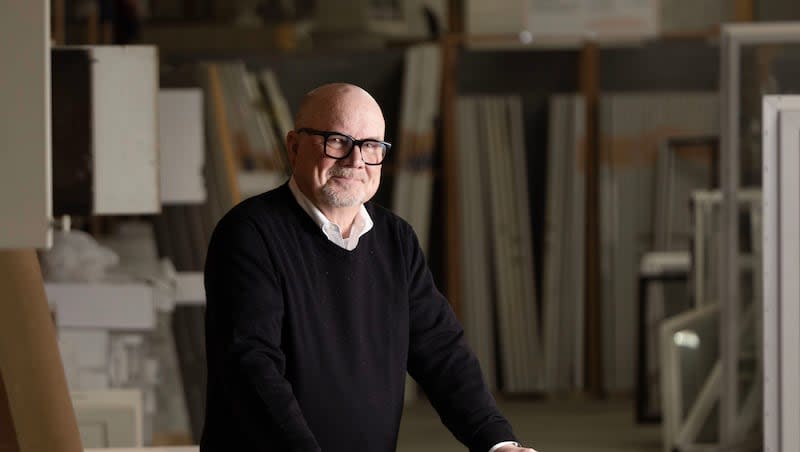‘Living big and living well are two different things’

- Oops!Something went wrong.Please try again later.
At the turn of the century, when he was asked by Habitat for Humanity to help find land for its housing projects, Ed Blake said sure. He was a real estate agent, after all, and also a mortgage broker. This was his wheelhouse. He’d be happy to help out for a while.
But as often happens when you sign on with a cause dedicated to helping others, he soon discovered that getting out isn’t as easy as one might think.
The first house dedication ceremony he went to, where he watched struggling but deserving families get their new homes at zero percent interest, he was hooked.
“It was the kids that really got me,” he recalls. “I saw these children who had been migrating all the time, every time the rent went up, mom and dad moved, and now they’ve found stability, they have their own home, they can settle down and be involved in baseball or a faith or whatever, and have a childhood more like I grew up in.”
And that’s how, for Ed, “a while” turned into 24 years.
* * *
One thing just kept leading to another.
Starting out as a volunteer on the real estate committee led to a position on the board of directors, which later led to a term as board chairman. Then, in 2010, when the CEO abruptly left, leaving the organization in the lurch, they asked Ed to “sit in the chair” until they found a suitable replacement for the full-time position.
Turned out he was the suitable replacement.
None of it was planned, least of all taking over as CEO. At the time, Ed was running two profitable businesses that required the bulk of his time and attention. He had zero interest in making a career move. He only agreed to keep the seat warm because the organization was in a pinch.
But now that he’d become addicted to the cause, and at the urging of his wife, Linda, he sat in the chair long enough to come to the realization he wanted to sell his companies and go all-in with Habitat. For less than half the pay.
“I have this motto, ‘Living big and living well are two different things,’ and it’s true, it’s absolutely true,” says Ed, who announced earlier this month that he’ll be stepping down as Habitat’s CEO this summer. He’s 66 now, he was 42 when he first joined the organization.
His tenure has seen the charity grow by leaps and bounds. Just a handful of Habitat homes had been built from 1986, when the Salt Lake branch originated, until the year 2000, when Ed got involved. Now there are more than 100 completed homes dotted up and down the Wasatch Front with dozens more that are either awaiting or are currently under construction.
A big corner was turned in 2009, when Ed, as board chair, led the effort to open ReStore, the charity’s thrift store that sells donated building materials and other household items, new and used, at greatly discounted prices.
At the time, Habitat was headquartered in a 1,000-square-foot building on Van Winkle Expressway. Ed, who had seen the success of ReStore stores at other Habitat chapters around the country, made the pitch to move to a vacant 30,000-square-foot former Maytag appliance warehouse next to the freeway on 1300 South.
Most people thought he was crazy, and Ed wasn’t 100% sure they weren’t right. “I remember thinking, ‘we could never fill this, it’s way too big,’” he recalls. “Now we’re busting at the seams.”
The ReStore not only opened up a new revenue stream for Habitat, it became a clearing house for construction materials, furniture, appliances and other products looking for a home. Besides offering deep discounts on everything from toilets to bolts and screws to lawnmowers, It’s estimated that each year the ReStore keeps 800,000 tons of refuse out of the county landfill.
Other innovations during Ed Blake’s supervision have included the critical repair program, an effort that assists low-income people in making necessary, and often life-saving, repairs to their existing homes, and the hiring of professional builders to construct Habitat’s new houses.
The requirement for future homeowners to volunteer 225 hours of sweat equity to their home remains in place. But the skilled labor is now left to the professionals. “Volunteers can slow you down; sometimes you’re redoing their work,” says Ed as diplomatically as possible, “With professional builders, we are so much more efficient than we used to be.”
Through all the changes and improvements, however, Habitat for Humanity’s overarching mission remains unchanged: providing affordable housing to people who otherwise could only dream of such a thing.
Witnessing a family realize that dream, having a front row seat to such an event, is what’s kept Ed going for nearly two and a half decades.
“Income isn’t all money,” he says, “I could have made more money somewhere else, but there’s a great income that comes with putting families in homes. Like the one just last week, and the little 10-year-old boy who went up into his new bedroom and did snow angels on the carpet.”
More than anything, Ed’s going to miss those paydays.

